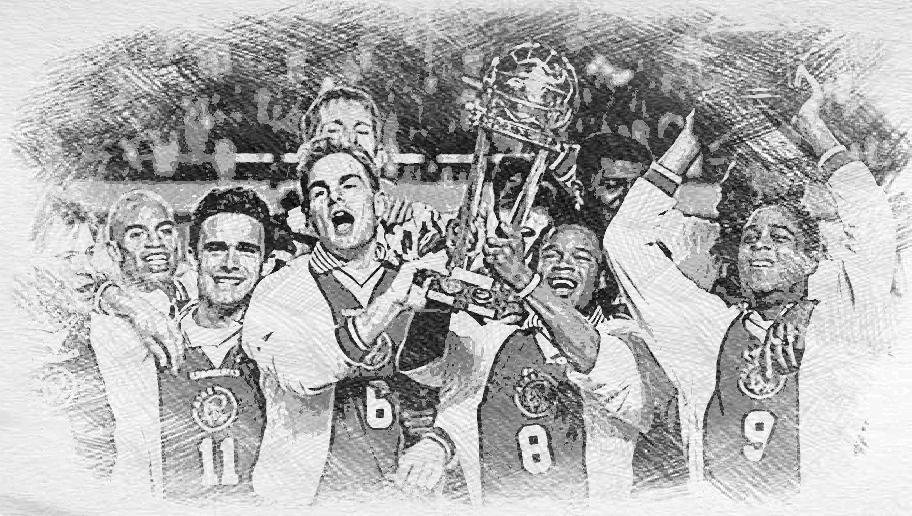
Total Football Journeyman: Bossing the Ball like 1995 Ajax
Part 2 of Building a Total Football Club in FM20
It is not about how long you have the ball, it is what you do with it. When playing possession football, you should always have this mantra in mind. Although I am not one to obsess over getting high possession numbers. Of course it is always nice to see your team getting the higher possession %. I see it as proof that my players are imposing themselves on the opposition and winning important battles. But despite winning the battles, one could still lose the war. I can’t recount the number of times that my team controlled the ball and still lost the game. And the times we did the same to the other side. Possession is definitely more than just having the greater %. It is about controlling the ball in the right areas and time. It’s about decisive movement Off and On the ball. It’s about overcoming the odds.
Part 1 Is Here:
Bringing Back The Wolves
I thought I would try something different for this piece and temporarily abandon my Royal Society save and 4-3-3 formation. As they say, there is more than one road to Rome. And there are multiple paths to Total Football.
While the classic 4-3-3 worked well with Sociedad, I feel my series is becoming larger than one club’s journey. I see it more of a tactical saga about restoring Total Football within the limits of FM20. So it should not be limited to a single club anymore. For my future articles I have a few clubs to choose from. I usually run multiple saves to test my tactics in different leagues and with clubs of various level. This does not mean that I won’t ever come back to Sociedad. I had a great time with them, creating my 4-3-3 formation that led us to one Champions League Final & 3rd place finish in FIFA Club World Cup, in 2 years. But I ran a parallel Total Football experiment with another historic tactic. It’s an old favourite of mine, and so to showcase it I’m going to bring back another favourite.
La Lupa is back baby!
Instead of my usual team introduction and analysis, I will jump straight into the midst of tactical analysis. I believe that my older Running with The Wolves Articles can still serve as a good introduction to the Giallorossi. The core of the team remains the same in FM20. As before Roma has a very technical squad and is one of the best teams to demonstrate Possession Football. I believe it’s a squad capable of both Possession with Intent and of getting the best out a classic #10.
David Versus Goliath: 101 of Possession with Intent
To me Possession with Intent, means two things. Firstly, getting the ball up from my Keeper to my strikers in the shortest most efficient way. While at the same time taking the least risks possible. That means I want quick touches and short to medium passes. Achieving overloads can help too. What I am definitely not looking for is hoofing the ball across the field up to the forwards. The aim still remains to maintain methodical attacking approach and not a defensive counter-attacking one. In other words I do not want my team to play as an underdog (even if they are). They need to be confident and aggressive in their possession by maintaining a high defensive line and intense level of pressing.
Second important element of Possession with Intent, especially when playing against “big teams”, is defensive balance. So you can be aggressive, but not to the point where you concede possession to the opponent needlesly or easily. As an underdog, you work hard to score your goals. It only makes sense that you must work even harder to not concede. To do this you must be able to efficiently and reliably shut down the opponent. Formations with three defenders are thus ideal.
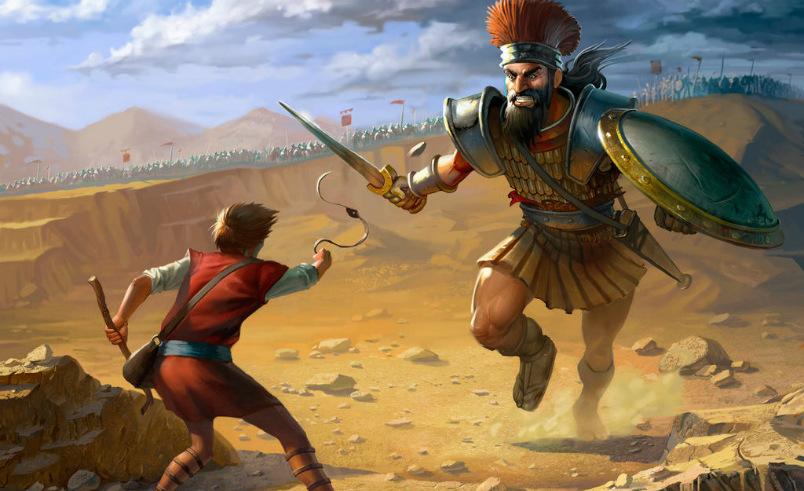
The 1995 Champions League Final between Ajax and AC. Milan was a real David Versus Goliath Showdown. While Van Gaal’s Ajax was full of exciting youngsters, they were still “green” and not used to the big stage. Seedorf, Patrick Kluivert, Frank de Boer, Edgar Davids and Edvin van der Sar were not the household names that they would become a few years later as they moved to some of the biggest clubs in Europe. Consequently, the achievement of winning Champions League against a more experienced Milan side is what put them on the map.
The youthful Dutch side was a definite underdog compared to Rossoneri. There was simply no doubt in the world-class status of the likes of Maldini, Gullit, Baresi, Donadoni, Boban and Savićević. Fabio Capello himself, while garnering the reputation a rigidly-dogmatic and harsh manager, was no pushover. The Italian was widely considered as the best tactician in the world after he bested Barcelona’s Total Football Dream Team led by no other than Johan Cruyff himself. The young Ajax, “David” were facing a monumental task in their match up against the “Goliath” Champions League defending champion.
Nurturing Total Football’s Creative Backbone
What set Louis van Gaal apart from Cruyff was his willingness to experiment tactically. He had a vision of how to make Dutch Total Football philosophy dominant again in the modern globalized footballing world. Like Cruyff before him, van Gaal invested into crafting a team capable of playing a highly attractive, technical possession football. Also like Cruyff’, van Gaal wanted to do this by using a 3-1-2-1-3 shape. Johann Cruyff developed this innovative formation while managing Barcelona in the 1980s and early 1990s. It was a smart evolution of the older 4-3-3 shape used by earlier 1970s Ajax and Dutch National side. And Van Gaal had no qualms over “adapting” it to his young Ajax squad. But unlike Cruyff, he managed to make if successful with an almost entirely home-grown academy-trained squad. One cannot win anything with kids you say? Think again.
SIDE NOTE: The 3-1-2-1-3 formation won Cruyff’s Barca four La Liga titles and one European Cup in 1992. It was a Total Football Dream Team.
The key to the formation was its graceful symmetry. Its three forwards mirrored the three defenders in the back, while the four-men midfield was the formation’s defining “jewel”. A diamond in fact. Then there was the creative backbone, made up of the Sweeper Ronald Koeman, Deep-lying Playmaker Guardiola and #10 Bakero. By putting his best playmakers in the shape’s spine allowed Cruyff to move the ball vertically with ease and efficiency. It was Possession with Intent at its best. And a natural way to play Vertical Tiki-Taka (before it was known as such) by building from the back. It was only natural that van Gaal wanted to emulate such beauty.
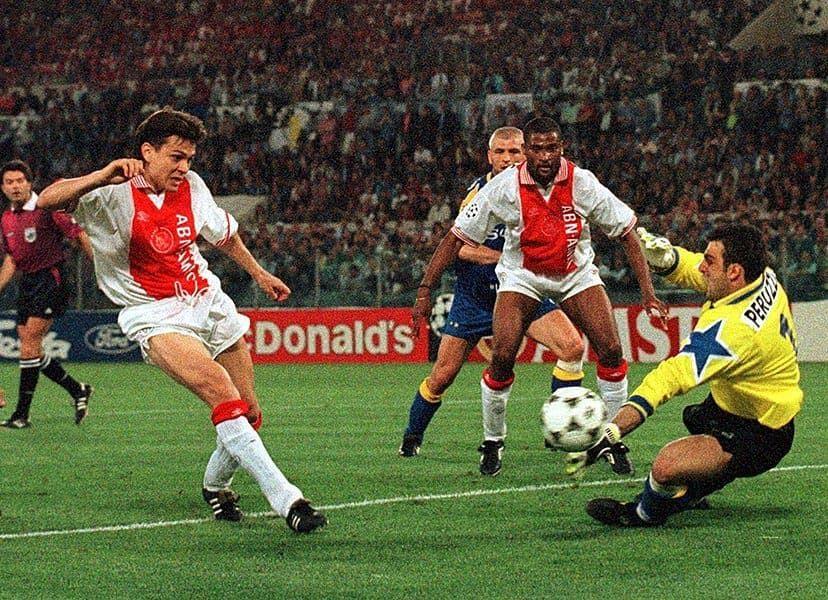
At the time Ajax possessed three world-class playmakers, Jari Litmanen, Frank Rijkaard and Danny Blind. The young Finn quickly became a fan favourite. Jari was famously described by the fellow teammate, and future Barcelona manager, Frank Rijkaard as ‘the best number 10 we ever had’. His cult status is well deserved as Litmanen was the creative heart of the formation’s central backbone. His value was in his exceptional Off The Ball Movement, First Touch and Vision for both passes and goals. A classic fantasista as any team could ever hope for.
If Litmanen was the formation’s creative heart, then Rijkaard was its brain. At 33, he was past his physical prime but his tactical intelligence was as sharp as ever. He possessed an acute mind for football with top decision-making, and eye to read the game. While at his prime he was a very versatile physical player, able to play anywhere from striker to centreback position, he settled into a deep-lying playmaker role by his career’s end. Surprisingly elegant for his size, he excelled in this role due to his great technique, passing and vision for link-up play. After possession was won, Rijkaard was always the first to start plays. Also as he patrolled the centre circle, he could be relied on to break up opposition’s play. He was the formation’s least mobile role, yet a valued one due to his wide range of passing options.
Interestingly, Frank’s career mirrored Guardiola’s, Barca’s own deep-midfield general, as he got to manage Barcelona from 2003 to 2008. Before handing the reins over to young Guardiola.
And then there was Danny Blind, one the best playmakers to ever play in the centreback role. Danny was Ajax’ answer to Barca’s Ronald Koeman. And he was far from “blind” regarding his famous smooth passes. He perfectly epitomized the mythical sweeper role. A role that is slowly becoming as extinct as the Classic #10.
Remembering 1995 Team
Ironically, Van Gaal’s match-up against Milan, was second time that the fluid Totaalvoetbal-inspired 3-1-2-1-3 faced Capello’s rigid 4-4-2. In the first meeting at 1994 Final, Cruyff’s Barcelona used a similar formation and came short. But the second time was the charm. So how did Louis van Gaal succeed where Johan Cruyff, Mr.Total Football himself, could not? Without further ado, let us take a look at how van Gaal’s formation played and how it could be translated into FM20.
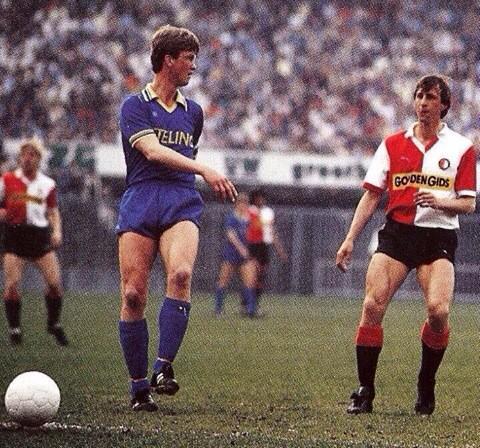
As much as Cruyff and Van Gaal hated each other they shared a common vision of the Dutch football philosophy. This involved maintaining width through two lightning quick wingers, and dominating the midfield with an extra player there. Much like Cruyff’s Barca, Van Gaal lined up his Ajax side in a symmetric 3-1-2-1-3. This shape was key to Cruyff’s vision of Total Football, because it allowed for three players in defence, three in attack and four in midfield. It was Cruyff’s 3-4-3 Narrow Diamond, one of the most celebrated football formations. It was also ideal for winning the possession battle.
The idea behind it was simple enough. It borrowed most concepts developed by Rinus Michels for his 4-3-3 shape with 1970s Ajax, and brought them to a whole new level. Its major advantage was that most other formations couldn’t outnumber a 3-4-3 in the midfield, and still be offensive enough going forward. It was the polar opposite of the much more defensive Italian Catenaccio. The passing triangles between the players in the diamond and the rest of the team just could not be matched. Finally, the three men in the back (even with one having more freedom as a sweeper) was a big advantage against most teams. Especially when the Deeplying Playmaker, the “extra man” (and often unmarked) would drop down to help out with defence.
But I am getting ahead of myself. Lets start with Attack, and dissect 1995 Ajax from formation’s top to its defensive trio at the bottom.
Attacking Trident

In attack, Van Gaal used two lightning fast wingers and a perfectly complete Striker Patrick Kluivert. Kluivert was ideal for leading the line due to the combination of strong athleticism, technical first touch and dribbling skills. He was also a very intelligent footballer who could just as easily support attacks as finish them. And the wingers, Overmars and George, stretched the play, dragging the opposition fullbacks wide and creating 1v1s. At the same time Kluivert led the line and pushed back the opposition centre-backs. Thus prongs of the trident acted in unison as decoys to create more space for the real star of the show. That happened to be the #10 fantasista Jari Litmanen who owned the advanced midfield space with his exceptional technique and intelligent movement. He was the spearhead of the diamond and also its invaluable jewel.
Midfield Diamond
Jari was not just a pure playmaker but also chipped in with goals, scoring a key goal in the final. Check out that beauty in the clip below.
At the same time as Litmanen crafted chances for the forwards, he rest of the diamond had equally specialized tasks. Edgar Davids and Clarence Seedorf flanked Rijkaard on both sides. They acted as the lungs and legs of the formation. Very hard-working and determined, they also possessed the technical skills to pass the ball around until it reached the forwards. Davids, nicknamed “The Pitbull” for his tenacity on the ball, was just 22. While Seedorf played well above his 19 years as he possessed the confident physicality and stamina of an older player. The “shuttler” duo was able to alleviate much of the defensive, pressing responsibility from the much older Rijkaard.
As I mentioned before one element of the diamond that Van Gaal copied from Barcelona was the Guardiola position. Where Barca had Guardiola, Ajax had Rijkaard. Rijkaard’s all-around technical ability allowed Ajax to shift between a back three and back four depending on the situation. If anything Rijkaard’s role was as essential to transition from defence as Litmanen’s role in attack. The video below is probably the best resource to learn about this all-important #4 role in 3-4-3. Especially if you would like the mastermind behind it to explain it to you in layman’s terms.
One important take-away message from the clip starts at 1:15 minute mark until about 4 minutes. So at least watch that before reading the rest.
As the team’s deep pivot, the #4 deep-lying playmaker, whether it was Cruyff’s Guardiola or Van Gaal’s Rijkaard, would start plays and control the ball around the centre circle. The idea was that by controlling the game from deep, you would control possession. Naturally a player with great passing range and vision is ideal here. One who could take the ball from the goalkeeper and bring it up to attack if need-be. Or drop back and prevent the opponent from advancing in your own half. In modern game this has become the domain of a technical half-back like Fernandinho at Man City. Although I still believe that in FM20 the best way to recreate this is with a Deeplying Playmaker on support. But more on this later.
Defensive Trio
The Ajax’s defence trio was pretty straightforward. Essentially Van Gaal used two regular defenders, Frank de Boer and Reiziger, flanking a more creative and mobile Danny Blind. As the lowest part of the formation’s creative spine, Blind had the instincts and technique of a playmaker. He had to pass the ball comfortably and quickly to Rijkaard while having the anticipation and mobility to drop behind and stop anything not picked up by Reiziger or de Boer. He would also “sweep” up any loose balls that the opposition forwards could run into. Working as a unit, this defensive trio managed to neutralize the majority of Milan’s attacking threat.
FM20 Tactical Translation and Disclaimer
How do we translate above into FM20? Or even more importantly how do you recreate the following in the game.
Historical tactic recreations are always tricky. In my mind some roles are more clear than others. So bear in mind that this set up is by no means final. There is still much experimenting ahead. One thing that I have been struggling with recently is accepting that the FM simulation is sometimes not as reflective of real football. In my mind and on paper I envision my players behaving in one way based on football theory. Then I watch the match in full and theory goes out the window as things become more “gamey”. In the best case scenario, one can use the exact role that the player supposedly played in. The worst is that to recreate his behavior a very different role might be needed. After-all, Football Manager is still a game, not reality as much as we wish it to be.
In my opinion, Ajax’ Defence should be two CBs on defend duty and a Ball-playing Defender on Cover. Since the Sweeper role is no longer available in FM20, the closest equivalent role is a CB on Cover duty. This duty instructs him to drop behind the other defenders and “sweep-up” loose balls or attackers that get past the other two defenders. Finally, I chose a Ball-Playing Defender role simply to reflect the creative role that Blind played on the team.
Rijkaard’s role has to be a Deeplying Playmaker, to reflect his important pivot position at the bottom of the diamond. Luckily, this role translates well into FM20 and works exactly as I need it too. Especially on Defend duty, it will help maintain the rigid structure of the diamond. Working alongside Rijkaard, Davids and Seedorf as the twin hard-working carrileros. In FM they are similar to box-to-box midfielders except they are more disciplined and less prone to make forward runs. Without wingers in the MR/ML strata, carrileros should cover the lateral areas. With help of PIs I instruct them to mark the opposite winger and better recycle possession to our attackers.
The tip of the diamond, was equally as important as its base. On paper Litmanen played as one of the last true Number 10s, a role that is virtually non-existent today. Just look at modern top clubs, like Liverpool or Man City, and try to name their player that embodies a classic Playmaker role. You might have difficulty there. Somewhat ironically, Classic #10 in AMC position is harder to make work in FM20 also. Or that is what many claim. In future articles, as I test the tactic more, I hope to show how the opposite can be true. A special creative player in AMC position can be very successful in both creating plays and scoring goals. But the key word here is that you truly need a “special” player. Jari Litmanen was the crowning jewel in that 1995 Ajax team. Here is mine at Roma:

Litmanen is most famous for his many goals, scoring as many as 91 goals in 159 appearances for Ajax. But he did not always operate in the opposition area. Rather he had a very good sense for off the ball movement. So he actually stayed in his central position most of the time, only making that run on goal when timing was perfect. Litmanen’s position within the diamond made it essential that he did not shirk his defensive responsibilities or deviate from his position too much. The times he did roam, he went backwards as much as forwards. Because the two carrileros were asked to track the opposition wingers, space opened in the midfield, isolating Rijkaard. To counter this, Litmanen dropped deeper into the midfield to support Rijkaard. Sometimes, pictures say more than words, as you can see in the following images, courtesy of the excellent blog by Tim Hill.
The best way to recreate this movement is probably via Attacking Midfielder role with custom Player Instructions and Personal Traits. The vanilla AM role is perfect for this you can tweak it in so many ways. AM could behave as a playmaker, shadow striker or a combination of the two, all based on how you set the PIs. For my AMC I will start with just a few PIs to make him act more like a playmaker. Thus to start off, I will go with “shoot less often” and “take more risks”.
The Wingers are the easiest to set up in this system. As I explained above one just needs a role to stretch the play and drag the opposition fullbacks wide. The simple Winger (Support) role should work just fine here.
I would use the AML/AMR version simply because I do not want them to get in the way of my carrileros‘ lateral movement. Here the key is the acceleration (along with good dribbling). At the top level I would prefer anyone with at least 17 for former, and 15 for the latter. Here is my ideal specimen at Roma, and he happens to be the son of the great Patrick Kluivert!
In contrast to the wingers, the central striker, Patrick Kluivert role, was the trickiest to get right in the system. This is partly due to the fact that Kluivert was such a complete player, able to play as both a supporting striker and an all-out attacking one. Depending on the videos or articles, there are contrasting opinions on Kluivert’s role. Would he drop to make room for Litmanen to run past or did he surge forward, pinning back the defenders? The truth was that the wonderkid probably did a combination of the two, depending on the phase of the game. Judging from the Champions League Final alone then you would think that Kluivert was a pure advanced forward/poacher. Yet evidence from the rest of his Ajax career, shows him playing more like technical creative striker.
So I decided to try something different in my tactic. How could I set him up to reflect both of these facets, staying back in support and breaking forward into opposition areas. In contrast to Litmanen I wanted my Kluivert to start deep and then push forward. What is the role that would help me model this behaviour? In the end, I took a little bit of inspiration from Roma’s own illustrious past. But that will be the topic for my next article where I will further expand on my tactic.
As a final treat, I leave you with this beautiful goal. It shows perfectly why Louise van Gaal’s team was best modern examples of Total Football. While Cruyff had his Dream Team of international superstars, his compatriot and rival managed to win everything with kids. And they did so while giving us a lesson on the value of hard work and teamwork. For if there was one thing that we all learned is that there is no Total Football without the Collective.
If you enjoyed this then please follow us on @ Dictate The Game’s Facebook and Dictate The Game’s Twitter. And check out some of our other articles



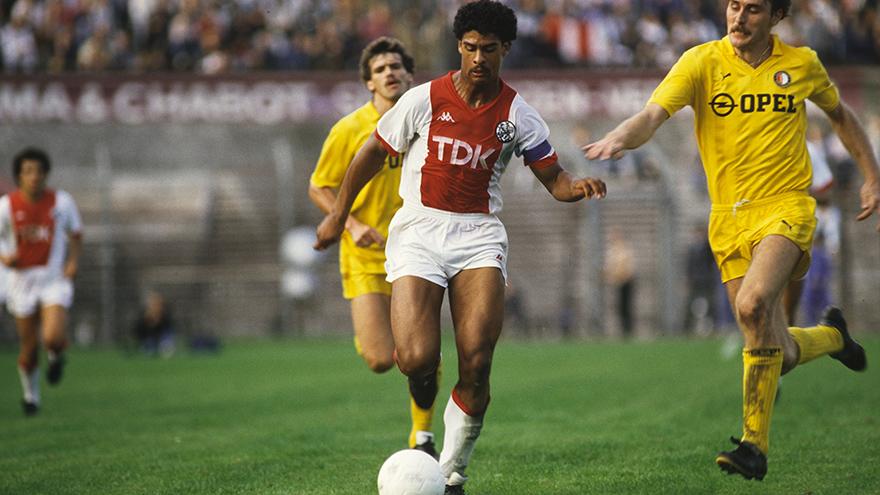


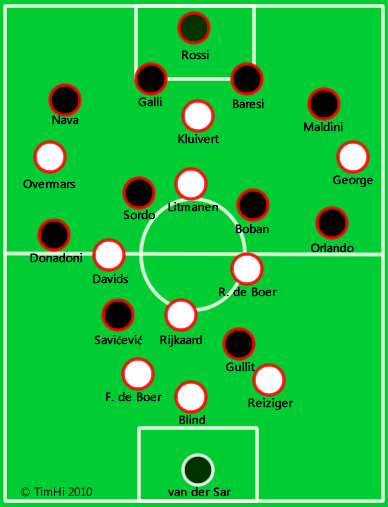

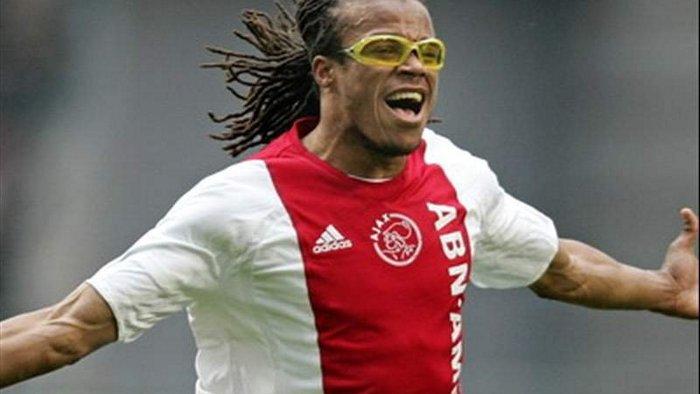
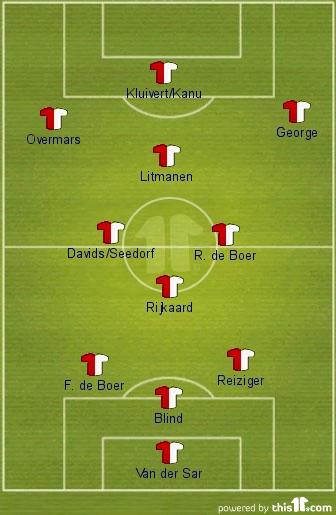

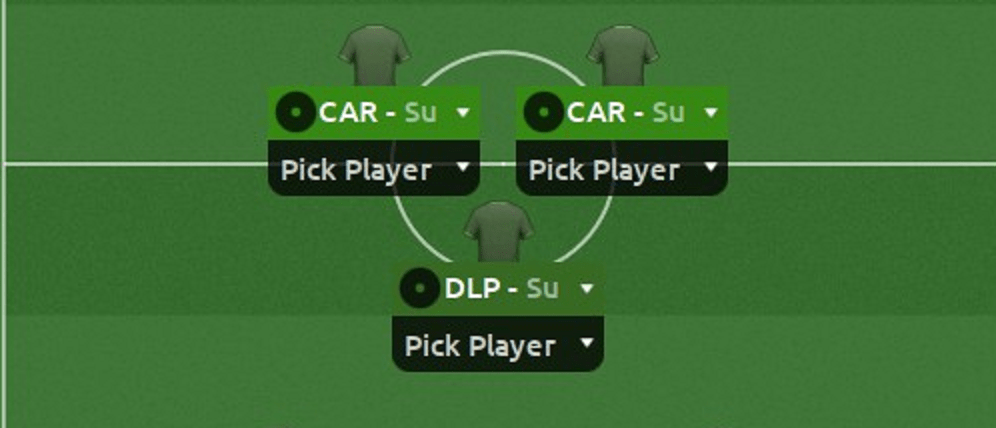

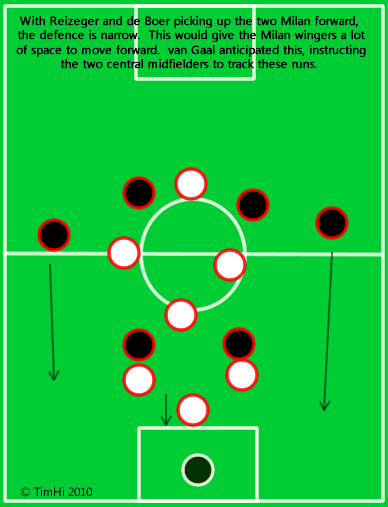



9 thoughts on “Total Football Journeyman: Bossing the Ball like 1995 Ajax”
Subi un enlace de descarga con tu idea de formación, roles y órdenes individuales…
Sorry, that is coming in the next update. A lot is not confirmed yet. I need to test the tactic for at least half a season to make sure it works as intended. It’s a very tricky tactic to get to work correctly in FM.
Where are the team instructions 🤔
They are in the Part 2 article which can be found here: http://dictatethegame.com/2020/05/13/total-football-journeyman-diamonds-will-break-anything/
You can also find the download link to the tactic in it. Thanks for reading and hope you enjoy it!
Loving your work!
Is there some tactic file we can download and test your version of total football?
Thanks! I put out a couple of downloads of different versions of my Total Football. Just look through the rest of the series of Total Football Journeyman. I usually post the download at the end of most articles.